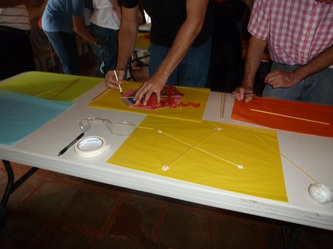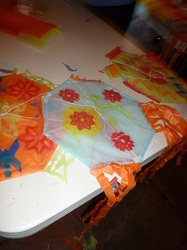While the kites of my childhood were shaped like diamonds, often made of newspaper and sporting rag tales, the Day of the Dead kites of Sumpango and Santiago are round octagons made of thin tissue paper (papel de chino) mounted on thin bamboo sticks . Four of the eight sides of the kite are decorated with “fringe,” made by cutting the tissue paper into decorative strips, often incorporating the complex techniques of paper cutting which Latin America is known for. The tail is made of two three- feet lengths of tissue paper, also cut in original designs which flutter like leaves in the wind. Julio explained that originally the kites were made from banana leaves and the glue from onions, but with time and the increased size and intricacy of the kites, the kitemakers had adopted tissue paper and a glue similar to Elmer’s.
Julio talked briefly about the kites as an important means of cultural identity for the Kak’icheqel Mayans, one of Guatemala’s twenty-two indigenous groups. Decoration of the kites often illustrates the Mayan belief of living in balance with the earth. Many elements of kite decoration incorporate the traditional Kak’icheqel designs which are found in Mayan weavings as well as ancient Mayan glpys. The kites also often addressinclude spiritual and political issues, such as human rights, respect for the earth and cultural recognition.
But this was not a lecture, Julio wanted to teach us how to make our own kites! To begin, we were each given four bamboo sticks and a sheet of colored “papel de chino.” Before this, the only way in which I’d used tissue paper was for wrapping presents! Assorted paper cups held glue accompanied by shorter thin bamboo sticks for applying the glue.
We each traced an octagon onto our paper using Julio’s model and assembled our sticks so that each point of our octogan was supported by one end of our sticks. We secured the sticks with a small bit of masking tape from the communal roll and then folded over a flap of tissue paper from the one inch margin we had been instructed to include when we cut out our octogans. Certainly the makers of the giant kites must develop considerable finess in applying glue with bamboo sticks! As I soon found out, too much glue wrinkles the paper and causes the colors to bleed through.
Once we had the octogan kite structure in place, our creative adventure in kite decoration began. Helpful assistants had already distributed pre-cut zigzag shapes to represent the designs in Mayan weavings. As we had only two pairs of scissors for our group of twenty-five, there was plenty of opportunity to lay out our zig zags and to watch others experiment with paper cuts. As we soon found out, it was one thing to lay out the design and another to glue it in place. Achieving a regulated flow of glue on a thin stick is an art in itself! And once the tissue paper with glue is applied, there is no sliding the design into a more perfect symmetry!
Everyone seemed to be completely absorbed in their process of creation. I was reminded of my classes as a communication professor at the University of Hawaii, where I led my students in making and flying kites as an exercise in cross-cultural communication, collaboration and the ongoing value of play in our lives. There as here, the kitemakers were totally captivated by the opportunity of making art that takes to the skies and dances with the wind.
The went quickly and the workshop was done before many of us had finished our long tails. Some people wanted only to hang their kites on the walls of their homestays, while Julio helped those of us who wanted to fly our kites punch holes (again with a sharpened bamboo stick) into the face of our kites and attach the string for flying.
Julio himself is passionate about los barriletes – both in terms of the joy they bring to all peoples and in their cultural significance for the Kak’icheqel Mayans. He happily agreed to talk with me more about the kites of Guatemala and to show me the giant kite his group is making when I return to Sumpango on Saturday to meet again with Oscar’s group. He even offered to lead this workshop again for the participants in my tour!
By the time I headed home, kite fringe fluttering in the air as my kite took to the breeze, I worried a bit about the gathering clouds, so often a harbinger of rain these September days in Antigua. Still, I couldn’t resist stopping to see my Guatemalan friends along the way and showing off my kite. And staying to hear about the kites they had made as children. And for once, the rain held off .










 RSS Feed
RSS Feed

